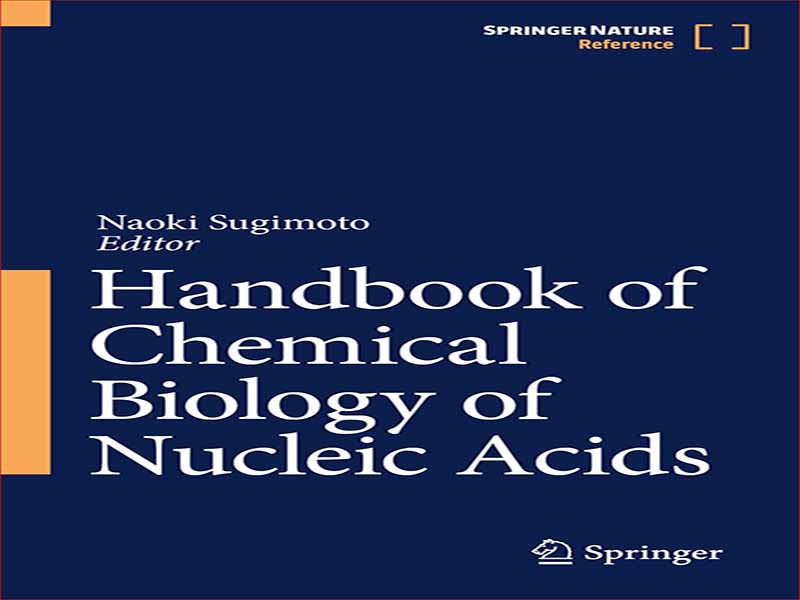- عنوان کتاب: Handbook of Chemical Biology of Nucleic Acids
- نویسنده: Naoki Sugimoto
- حوزه: بیوشیمی
- سال انتشار: 2023
- تعداد صفحه: 2847
- زبان اصلی: انگلیسی
- نوع فایل: pdf
- حجم فایل: 81.3 مگابایت
یکی از مهم ترین و جالب ترین مولکول های زیستی، اسیدهای نوکلئیک است: DNA و RNA، اگرچه اسیدهای نوکلئیک از مواد بسیار ساده تشکیل شده اند: فسفات، قند و بازهای آلی. ساختار آنها در مقایسه با سایر مولکولهای زیستی مانند پروتئینها و کربوهیدراتها، بهعنوان تک رشته یا یک مارپیچ دوگانه بسیار ساده است. با این حال، اسیدهای نوکلئیک دارای اطلاعات و عملکردهای ژنتیکی بسیار مهمی هستند. اسیدهای نوکلئیک مولکول هایی هستند که اطلاعات ژنتیکی را حمل می کنند و می توانند خود همانندسازی شوند و بیان ژن را انجام دهند. خاصیت شیمیایی اساسی همانندسازی اسید نوکلئیک جفت شدن باز بین نوکلئوبازها است. در سال 1953، واتسون و کریک یک مارپیچ دوگانه متعارف راست دست متشکل از دو رشته DNA را گزارش کردند. از طرف دیگر، اسیدهای نوکلئیک می توانند جفت باز هوگستین را تشکیل دهند که برای تشکیل ساختارهای غیر متعارف مانند ساختارهای تریپلکس و چهارگانه استفاده می شود. می توان در نظر گرفت که موجودات زنده می توانند از “کدهای ژنتیکی” مارپیچ دوگانه متعارف و “کدهای عملکردی” ساختارهای غیر متعارف استفاده کنند. از آنجایی که اختلال در تعادل در تشکیل ساختارهای غیر متعارف می تواند باعث سرطان، بیماری های عصبی و سایر بیماری ها شود، نه تنها مکانیسم اساسی تشکیل ساختارهای اسید نوکلئیک در سلول ها، بلکه کاربردهای درمانی نیز برای هدف قرار دادن اسیدهای نوکلئیک مرتبط با این بیماری ها است. در حال حاضر یکی از بزرگترین موضوعات در زمینه علم و فناوری اسیدهای نوکلئیک می باشد. در این سال (2023) که به مناسبت هفتادمین سالگرد کشف مارپیچ دوگانه DNA است، بسیار خوشحالم که این کتاب راهنمای زیست شناسی شیمیایی اسیدهای نوکلئیک را به عنوان سردبیر منتشر می کنم. این به 10 بخش شامل 90 فصل تقسیم شده است که نویسندگان نه تنها دانش پایه بلکه تحقیقات برتر اخیر را ارائه می دهند. هر بخش شامل فصول بررسی گسترده ای است که شیمی، زیست شناسی و بیوفیزیک اسیدهای نوکلئیک و همچنین کاربردهای آنها در پزشکی مولکولی، بیوتکنولوژی و نانوتکنولوژی را پوشش می دهد. تمام بخش های این کتاب شامل شیمی فیزیکی اسیدهای نوکلئیک (ویرایشگر بخش: پروفسور رولاند وینتر)، شیمی ساختاری اسیدهای نوکلئیک (ویرایشگر بخش: پروفسور یانز پلاوک)، شیمی آلی اسیدهای نوکلئیک (ویرایشگر بخش: پروفسور پیت هردویجین)، شیمی لیگاند اسیدهای نوکلئیک (ویرایشگر بخش: پروفسور Marie-Paule Teulade-Fichou)، اسیدهای نوکلئیک و بیان ژن (ویرایشگر بخش: پروفسور سینتیا باروز)، روشهای تحلیلی و کاربردهای اسیدهای نوکلئیک (ویراستار بخش: پروفسور چائوی یانگ) ، نانوتکنولوژی و زیست شناسی نانومواد نوکلئیک اسیدها (ویرایشگر بخش: پروفسور ژن ژی)، درمان با اسیدهای نوکلئیک (ویرایشگر بخش: پروفسور کاترین سلی رادکه)، بیوتکنولوژی و زیست شناسی مصنوعی اسیدهای نوکلئیک (ویرایشگر بخش: پروفسور اریکز روتس) و اسیدهای نوکلئیک عملکردی (ویرایشگر بخش: پروفسور کیت آر. فاکس). کتاب راهنما توسط رهبران برجسته با مشارکت های نوشته شده توسط کارشناسان مشهور بین المللی ویرایش شده است. این یک منبع ارزشمند نه تنها برای محققان بلکه دانشجویان فارغ التحصیل برای کار در زمینه های مرتبط با اسیدهای نوکلئیک است که مایلند در مورد نقش مهم و کاربردهای بالقوه آنها اطلاعات بیشتری کسب کنند. ای کاش همه خوانندگان از این کتابچه راهنما لذت ببرند و اهمیت نه تنها اسیدهای نوکلئیک دو مارپیچ واتسون-کریک (شکل B) بلکه اسیدهای نوکلئیک غیر متعارف مانند تریپلکس و کوادروپلکس را نیز بدانند. به جای هملت نوشته ویلیام شکسپیر، لطفاً به سؤال «به B یا نه به B، این سؤال است» در زمینه تحقیقاتی اسیدهای نوکلئیک پاسخ دهید. از همه نویسندگان و ویراستاران بخش به خاطر مشارکت های برجسته شان، و تیم ویرایش Springer Nature، به ویژه آقای شینیچی کویزومی و خانم S. Shameem Aysha، برای حمایت ارزشمندشان و تشویق من برای مدت طولانی، عمیقا سپاسگزارم.
One of the most important and interesting biomolecules is nucleic acids: DNA and RNA, even though nucleic acids consist of very simple materials: phosphate, sugar, and organic bases. Their structures are also very simple as single strands or a double helix, in comparison with other biomolecules such as proteins and carbohydrates; however, the nucleic acids have very important genetic information and functions. Nucleic acids are molecules that carry genetic information and can self-replicate and do gene expression. The basic chemical property of nucleic acid replication is base pairing between the nucleobases. In 1953, Watson and Crick reported a righthanded canonical double helix consisting of two DNA strands. On the other hand, nucleic acids can form Hoogsteen base pairs, which are used to form non-canonical structures such as triplex and quadruplex structures. It could be considered that organisms can utilize the “genetic codes” of the canonical double helix and “functional codes” of non-canonical structures. As perturbation of the balance in the formation of non-canonical structures can cause cancer, neurodegenerative disease, and other diseases, not only the fundamental mechanism of the formation of nucleic acid structures in cells but also the therapeutic applications targeting nucleic acids related to these diseases are one of the biggest topics in the field of science and technology of nucleic acids now. In this year (2023) which commemorates the 70th anniversary of the DNA double helix discovery, I am very happy to publish this handbook Chemical Biology of Nucleic Acids as the Editor-in-chief. It is divided into 10 sections including 90 chapters where authors present not only basic knowledge but also recent top research. Each section consists of extensive review chapters covering the chemistry, biology, and biophysics of nucleic acids as well as their applications in molecular medicine, biotechnology, and nanotechnology. All sections within this handbook are Physical Chemistry of Nucleic Acids (Section Editor: Prof. RolandWinter), Structural Chemistry of Nucleic Acids (Section Editor: Prof. Janez Plavec), Organic Chemistry of Nucleic Acids (Section Editor: Prof. Piet Herdewijin), Ligand Chemistry of Nucleic Acids (Section Editor: Prof. Marie-Paule Teulade-Fichou), Nucleic Acids and Gene Expression (Section Editor: Prof. Cynthia Burrows), Analytical Methods and Applications of Nucleic Acids (Section Editor: Prof. Chaoyong Yang), Nanotechnology and Nanomaterial Biology of Nucleic Acids (Section Editor: Prof. Zhen Xi), Nucleic Acids Therapeutics (Section Editor: Prof. Katherine Seley-Radtke), Biotechnology and Synthetic Biology of Nucleic Acids (Section Editor: Prof. Eriks Rozners), and Functional Nucleic Acids (Section Editor: Prof. Keith R. Fox). The handbook is edited by outstanding leaders with contributions written by international renowned experts. It is a valuable resource not only for researchers but also graduate students for working in areas related to nucleic acids, who would like to learn more about their important role and potential applications. I wish all readers enjoy this handbook and know the importance of not only Watson–Crick double helical nucleic acids (B-form) but also non-canonical nucleic acids like triplex and quadruplex. Instead of Hamlet by written by William Shakespeare, please answer the question “To B or not to B, that is the question” in the research field of nucleic acids. I am deeply grateful to all the authors and section editors for their outstanding contributions, and the Springer Nature editing team, especially Mr. Shinichi Koizumi and Ms. S. Shameem Aysha, for their valuable support and for encouraging me for a long time.
این کتاب را میتوانید از لینک زیر بصورت رایگان دانلود کنید:


































نظرات کاربران